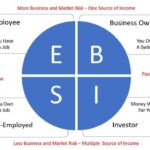Robert Kiyosaki, the author of Rich Dad Poor Dad, uses a model he calls the Cash Flow Quadrant to explain different ways income is generated. When you are self-employed, you own a job. The government also refers to this group as non-employer businesses, where the owner is the only employee. When you are self-employed you trade one boss for several bosses, known as your customers. While you have the flexibility to work the hours you want, you get paid only when you are under contract. The more you work, the more you get paid. There are no paid vacations or holidays for the self-employed.
Some self-employed individuals will derive income from several concurrent contracts, thereby achieving some level of diversification in their income. However, many self-employed workers simply work for a previous employer or for a single customer as a contractor and do not achieve any income diversification. In fact, many self-employed individuals have undertaken more income risk by becoming self-employed, with little if any additional compensation.
In terms of taxes, the self-employed person will have to pay the employer portion of FICA in addition to the employee portion, which is known as the self-employment tax on all taxable income. However, many business expenses such as cell phones, travel, etc. can be paid for using pre-tax dollars, providing the self-employed opportunities to reduce their taxable income. Savvy self-employed individuals price their services to adequately cover all their indirect expenses, including the additional employer-paid FICA share as well as any downtime experienced between projects.
How much of your income comes from self-employment, and is it priced properly?
Related posts:












